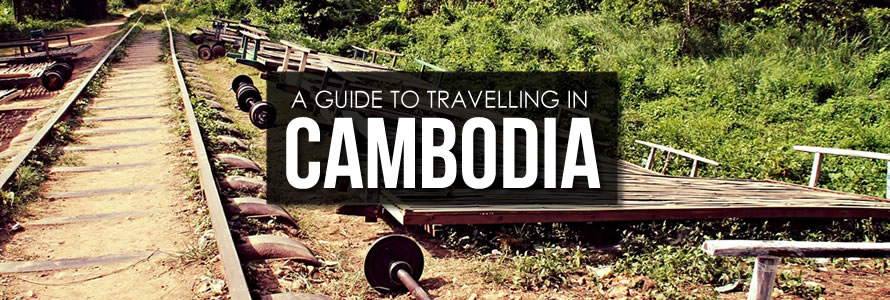Cambodia is one of the countries often included in the South-East Asia traveller’s route and offers all of the exotic colour, culture and charming chaos which this corner of the world is both famed and loved for. Within its menu of potential adventures and destinations are nature-rich jungle exploration, idyllic tropical beaches and islands, the faded grandeur of colonial leftovers and a vast variety of off-the-beaten track places where few tourists wander. What it is perhaps best known for are its temples – once part of an ancient and mighty empire – which come on a vast scale; others are straight from the set of a fantasy movie – half swallowed by the trees and vines of the jungle.
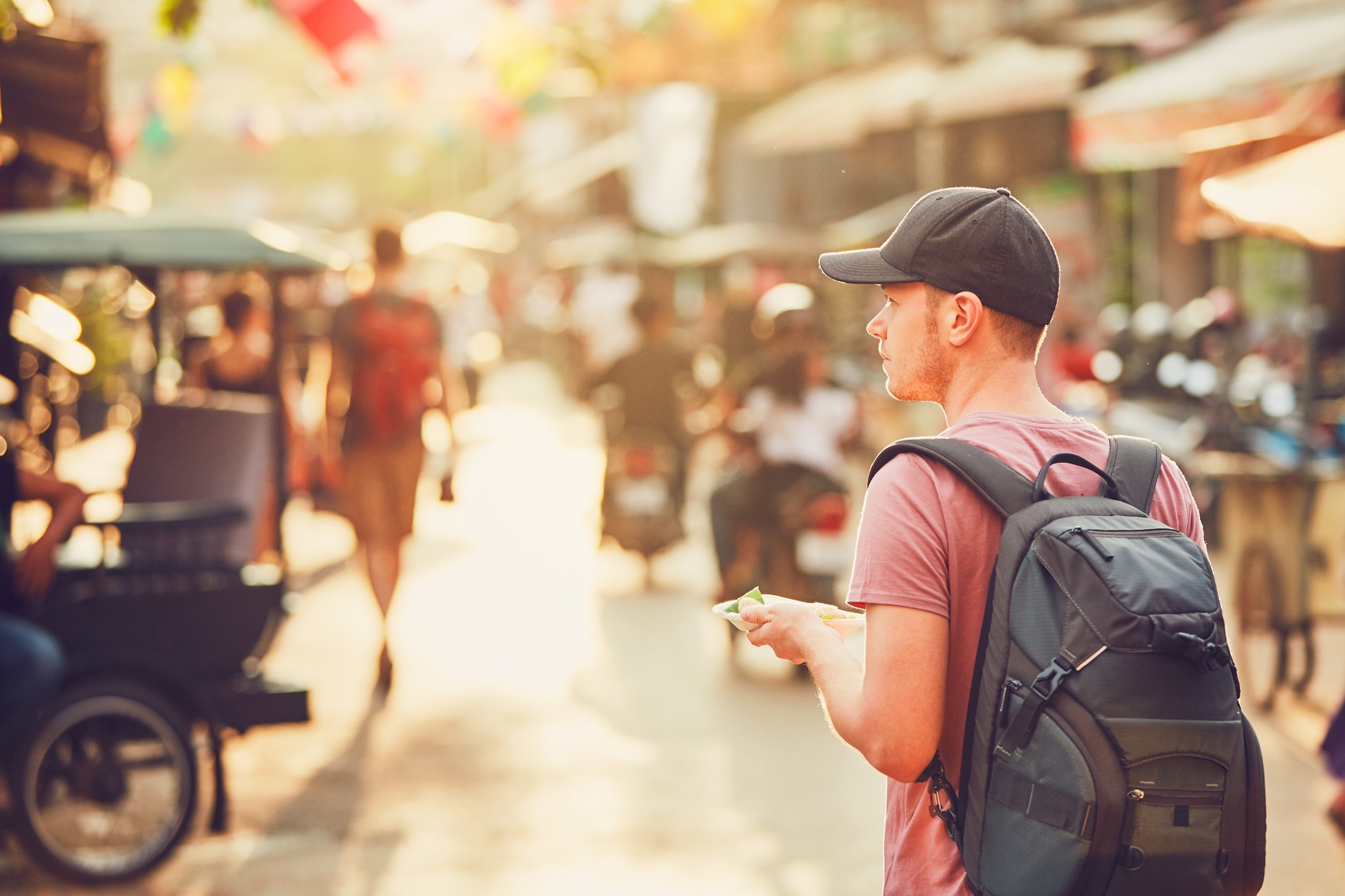
Also woven into the history of this country is a relatively recent story of shocking genocide – one of the worst the world has ever known. Despite this large scale tragedy, the Cambodian people are often noted as being one of the friendliest and welcoming in the whole of the South-East Asian area.
The following will give you a quick run through of all the essential elements such as getting in and around, accommodation options, food, culture and so forth which will help you plan your Cambodian travels.
Visas
For the majority of Western visitors – whether you are crossing into Cambodia overland or arriving by plane – you can obtain a visa on arrival for a fee. This is valid for 30 days. Not all the border entry points offer visa on arrival options so check in advance if you intend to enter Cambodia by land. To make life even simpler you can apply in advance for an e-visa online which costs a handful of pounds more than paying the visa fee on arrival. The processing time for this is typically three days. If 30 days simply isn’t enough to enjoy all the Cambodian delights you can extend your visa for another 30 days but after this you will have to leave the country and re-enter if you want extra time.
Weather & Seasons in Cambodia
Cambodia’s latitude places it firmly in the world’s tropical belt which means whatever time of year you decide to rock up you will have high temperatures. These can range from pleasantly warm to bakingly hot and sticky. Like most of the tropical countries the main differences in the weather patterns in any year are marked by the rainy season and the dry season.
The dry season – Running from October to April/May the dry season (which by the way doesn’t mean zero rainfall) typically has temperatures ranging between 24°C to 30°C during the day and around 20°C at night. Just before the rainy season starts – April and May – things can get especially hot and sticky with minimum temperatures of around 32°C which can rise ever upwards and even hit the 40°C mark. November to February are the coolest months which tend to make them the most popular with tourists.
The rainy season – This season runs from May to September/October with daytime temperatures typically hovering around the 25°C to 27°C mark. Just as the dry season doesn’t mean it is always dry likewise it doesn’t rain constantly in the rainy season. Downpours – which can be dramatically deluge-like – tend to occur only for brief periods in the afternoons. Tourist numbers are generally lower during this season which means prices are lower too and everything appears lush and green. The only real downside to visiting during this time is that some dirt road routes can become impassable.
Health & Personal Safety Issues in Cambodia
As countries on the South-East Asian circuit go Cambodia is relatively trouble-free and safe with a general friendliness and welcome extended to the country’s visitors. There are a handful of things you might want to be aware of though.
Theft – Like pretty much anywhere in the world it pays to be a little extra vigilant in cities and more crowded areas such as Phnom Penh and Sihanoukville where petty theft is far from rare. And also – just as with anywhere else – don’t flash your valuables in the street such as phones, cameras or other electronics. One particular annoyance which could prove costly is the incidence of bag or phone snatching by drive-by thieves on motorcycles, often working in pairs. Their targets are pedestrians or anyone riding in a tuk-tuk or other partially open public transport who hasn’t kept a close eye on their bags or belongings. Thefts seem to reach particular peaks in periods running up to festivals.
Violent crime, although not completely unknown, is rare.
Scams – For the majority of tourists typically the highest chances of encountering unpleasant issues is by falling foul of some scam. Like the rest of South-East Asia these are super common and range from the annoying – which rob you of little more than your time – to those which could see your travel funds gobbled up in one fell swoop. Many of the tricks are so old they have been doing the rounds since tourists first started arriving here so asking fellow travellers or accommodation staff for the low down on the most common can usually keep you a step ahead of the inventive scammers. Some of the most potentially costly scams (which come in a variety of forms) revolve around motorbike rental which is very common here; forearmed is definitely forearmed where these are concerned. It can also help to do a bit of advance internet research to see what new scams are surfacing at the time of your travel.
Landmine hazards – If you are the type of traveller who likes to wander off alone exploring more remote destinations or jungle areas you are going to have to forego such habits in Cambodia. Incidences of inadvertently stumbling across unexploded mines or other ordnance leftover from the war years of the 70’s is not as likely as it once was but it does still happen. The greatest risk areas are those such as Preah Vihear around the Thai border and Pailin in the north which was once a Khmer Rouge-infested area.
Health hazards – For the vast majority of Cambodian visitors the sun and the risk of dehydration will present the biggest health hazards so take steps to protect yourself, especially when you first arrive. A particular potentially dangerous element here is when the sun is mixed with alcohol. Not only does the alcohol make you forget to reapply that sunscreen or become a little more oblivious to the fact you’re getting baked but it will also accelerate any dehydration.
The other area where you might want to exercise a little caution is where food is concerned with the ‘cook it, boil it or peel it’ mantra typically helping to keep the majority healthy. A touch of traveller’s tummy is almost unavoidable through but is typically just a 24 hour thing.
Diseases – There are a few infectious diseases present in Cambodia so – just as with all travel destinations – it pays to make a visit to a travel clinic before arrival to be sure you are vaccinated against the higher risk illnesses or have adequate malaria protection. Dengue fever is present at times in Cambodia with occasional outbreaks in specific areas. This mosquito-borne disease has no preventative medication or vaccine, so protecting yourself from bites by using mosquito repellent is the only step you can take to prevent it.
Wildlife hazards – Cambodia does have its share of venomous snakes but most of these will be long gone as soon as they hear you coming and before you even catch sight of them. Leeches – which are ever present in humid jungle areas – are always looking for a passing animal or human to attach themselves to with the unexposed legs of trekkers being an easy target for them. Sand-flies are another annoyance in coastal areas and although not harmful in themselves have extremely itchy bites. The hazard here comes with scratching that itch and creating an open wound which in the tropics can quickly become infected if you’re not on your guard.
Accommodation Options in Cambodia
Just what is up for grabs on the accommodation option front will depend where you are in Cambodia. If you are in Phnom Penh, another large urban centre or anywhere on the well-established tourist trail you can expect everything from cheap and cheerful guest houses and hostels to luxury end hotels. In more rural areas authentic experience home-stays are popular with the travelling set.
Phnom Penh, Siem Reap and the beach destinations of Sihanoukville offer tons of choice and with competition so fierce you can expect the lowest prices if you don’t instantly head to the most popular streets or guidebook-listed properties. Around the beach and the islands simple beach bungalows and huts are commonplace and can typically be had for a handful of dollars.
Cambodian Food & Drink
While Cambodian cuisine tends to fall into the shadow of its more famous cousin Thailand it can be a real treat for foodies, especially those with an adventurous streak. Just as almost everywhere else in South-East Asia street food offers not simply a great option for those on a tight budget but dishes up treat after treat for those who are in search of authentic flavour-packed options. Some of the more often found dishes include the sweet and spicy egg noodle stir-fry dish known as lort cha, the coconut fragrant sticky rice which is both cooked and served up in bamboo sticks and deep fried foods such as shrimp cakes. Those with a leaning towards sampling the rather more weirdly exotic can get their teeth into freshwater snails, grilled worms and bagfuls of crunchy crickets. Otherwise menu options include curries (from mild to hot), marinated salads which will appeal to cerviche fans, various noodle or rice heavy dishes and a vast choice of fresh fish and seafood around coastal areas.
Money Matters in Cambodia
The currency of Cambodia is the riel but as a tourist or traveller you will mostly see prices in US dollars and be paying for things with dollars. That doesn’t mean you won’t have riels in your wallet though – whenever you get change it is usually given in riel.
Outside of the bigger shops, restaurants and accommodation options in the more built-up places don’t expect to be able to use your credit card; this is still the land of cash. Cash dispensing machines are not hard to find in the towns and cities but are fewer and further between in more rural or off-the-beaten-path places.
Tipping isn’t a big part of Cambodian culture unless you intend to lie your head down in fancy hotels, eat in upmarket restaurants or hire drivers for full-days. Where tips are given they are typically in the region of a couple of thousand riel which is less than 50p for a Brit and 50c for a US American.
Cultural Issues in Cambodia
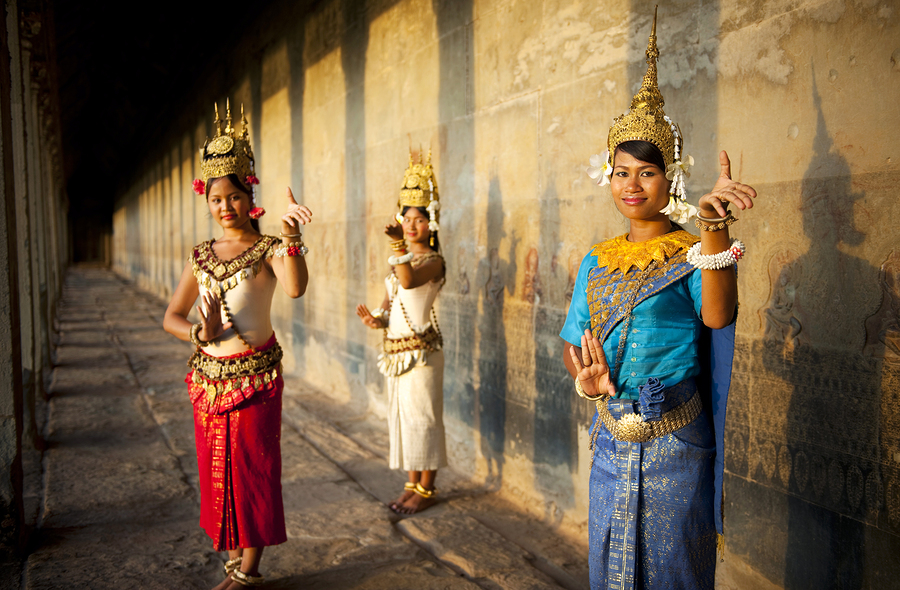
Around the most touristy places such as Siem Reap and Phnom Penh locals are so inured to visitors and what they will often consider strange ways you can get away with being less culturally aware without hitting any snags. However, away from these centres there are a few things it can help to know to avoid making cultural slip ups which can either be embarrassing for you or offensive for your hosts.
Dress – Anything which finishes above the knee or doesn’t cover the shoulders is considered provocative dress in Cambodia and while you are going to see Westerners frequently dressed in short shorts and sleeveless tops it doesn’t mean the locals like it even if they tolerate it. Women dressed like this can expect to be stared at and if you want to visit any temples you are going to have to cover up. Be aware that if you dress like this away from the tourist centres you are going to offend locals. Likewise, Cambodians have long been used to seeing Westerners in bikinis at the tourist beaches but you are unlikely to see any local women so attired. You don’t need to cover up quite as fully as the locals but be as aware and respectful as you can.
Public displays of affection – Cambodian couples rarely show any signs of affection outside closed doors and anything too overt is typically considered nothing short of shocking.
History and politics – It would be ignorant and disrespectful to come to Cambodia without knowing something about this country’s tragic history. The reason being is that anyone here around middle age or older will have lived through the genocide years and the horrors of that era. This means you will need to tread very carefully and sensitively on the subject of the Khmer Rouge and it is usually best avoided altogether unless you are visiting somewhere such as the Killing Fields. Likewise, the current political climate and its different factions can mean some innocent comment turning to heated debate very quickly so is again best avoided. Another subject best left alone is that of Vietnam and its people. You can if you choose research the historical whys of this but otherwise just steer clear of making any comparisons between Cambodia and Vietnam.
Transport Options in Cambodia
There are a ton of ways to get from A to B while you are in Cambodia – here are the most frequently found.
Long Distance Options
- Plane – Domestic air travel in Cambodia can be ridiculously cheap and it always pays to check out schedules and prices before considering the longer distance journeys.
- Bus – Whether local or visitor this is the most frequently used form of public transport for getting around the country. Quite what you will get depends on how much you want to pay with the cheapest options being rattley chicken buses which take the longest to comfortable air-con vehicles which ply the tourist routes and are the fastest, most direct choice. Even the highest end choices though are incredibly cheap by Western standards.
- Vans & mini-buses – These are as commonly found as the buses in major destinations but aware that some providers really cram them full so they can be uncomfortable.
- Boat – Some routes are covered by boat options such as Phnom Penh to Siem Reap or Battambang to Siem Reap although seasons will dictate both journey times and frequency of services.
- Train – Recent renovations have added rail journeys to the possible transport options of Cambodia but they are as yet still limited to that of a Phnom Penh to Sihanoukville journey. There are further possibilities in the pipeline though with Phnom Penh to Battambang supposedly next to be completed.
Local Transport Options
- Tuk-tuks – These crazy little three-wheelers are everywhere in Cambodia – unavoidable in the cities and even found in some of the most far-flung destinations. Always agree a price before climbing aboard.
- Driver & car rental – If you are travelling with friends this can be an incredibly cheap way of doing things. Drivers of this kind are in plentiful supply and are normally rented by the day.
- Remork-moto – Filling the niche of a bus in the countryside, think motorbike with attached trailer and you have imagined a remork-moto. In the cities or tourist spots the remork comes with a canopy and space for two people to sit side by side.
- Cyclo – Also known as a bicycle rickshaw or pedicab, cheap option cyclos are still found in most populated areas but seem to be in something of a decline.
- Motorbike taxis – Sometimes just referred to as motos, these motorbikes which come with a driver can be found in high numbers in certain places.
- Bus – Phnom Penh has a few local bus route options but they are at present not found elsewhere.
- Outboards – These water taxi services are found throughout Cambodia where applicable and boats generally set off once they are full rather than following specific timetables.
- Taxis – The ease of getting a taxi will depend on where you are with surprisingly few in some of the tourist hot spots.
- Motorbike hire – As is also true in many other parts of South East Asia motorbike hire is popular and can be a cheap way of getting to out-of-the-way places under your own steam and on your own schedule.
Essential Highlights of Cambodia
The Angkor Temples
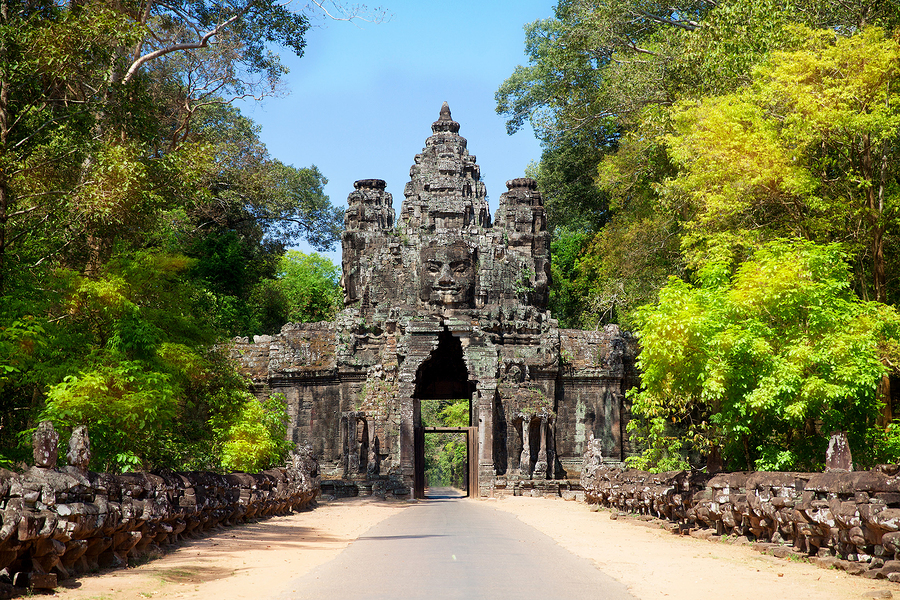
World Heritage listed, vast and dating from the 12th century, Angkor’s temples are the main if not only reason for most people wanting to visit Cambodia. Besides its wow appeal for tourists Angkor is also a major magnet for the religiously devout and happens to be the world’s largest religious monument. Unearthed from its covering blanket of jungle in the 1800s, the Angkor complex also includes the Bayon Temple which is a three level labyrinth of galleries, towers and passages with the highlight considered to be the carved stone faces which stand 4 metres high. Ta Prohm is also part of Angkor but because it is located a little ways from the main event temples is often missed. Those who do make their way here often describe it as their favourite part because, unlike much of the rest of the complex, this fantasy film set-like tree-root entwined crumbling monastery ruin has been left much as it was found. Its general appearance is so mystery-filled it was used as set for both Tomb Raider’s film and video game.
Tuol Sleng Genocide Museum and The Killing Fields
While visiting these highly evocative sites is unlikely to be the easiest emotionally or most fun you have had travelling they are incredibly important if you want to understand anything of what this country has been through. During a 4 year period in the 1970s Pol Pot and his Khmer Rouge regime put more than 3 million people to death – all the more shocking as both murderers and slaughtered were fellow Cambodians.
Approximately 17,000 people, children included, passed through what is now the Tuol Sleng Museum – which was a school before it became the interrogation centre known as S-21 – in order to undergo confession extraction through torture. Just 7 of those lived to tell the tale.
The ‘Killing Fields’ are a collective set of sites where prisoners were brought to be executed. Choenung Ek was just one of these which today can be visited. Perhaps the most haunting aspect of this place is the Memorial Stupa inside of which can be found seemingly endless numbers of skulls of the victims arranged by sex and age.
Phnom Penh
Charm, chaos and a lovely river-front complete with tropical coconut palms are all part of this capital city which was once known as the pearl of Asia. Phnom Penh has plenty of things to see and do – the Royal Palace complete with tropical gardens and a diamond-encrusted Buddha, the Silver Pagoda with its solid silver floor and the National Museum are generally considered to be its essential highlights.
Tonle Sap Lake and the ‘Floating’ Villages
Double the size in rainy season, Tonle Sap Lake is South East Asia’s largest and the site of the much photographed floating villages made up of former boats and decidedly ramshackle structures. These floating villages – home to 1.5 million fishermen, farmers and a rare few others – are actually a misnomer because the houses are in reality raised on stilts but when water levels are high they do indeed appear to be floating.
Self tours are possible as are adventures into the flooded forests and nature reserves during rainy season. Most, however, go with something organised which typically means you get to see more and if you’re up for something authentic opt for one of the home-stays here.
Sihanoukville and other beach lazing and island retreats
Because it doesn’t have much coast Cambodia is often overlooked by those intent on beach bumming. However, what it does have tends to run to the tropically idyllic white sand/azure water variety and there are a few Robinson Crusoe-like island escapes to choose from as well. Several of these are popular as day trips or for more extended stays for those who have no need of TV, internet and electricity. The backpacker set tend to descend on the beaches around Sihanoukville where partying is the watchword.
Battambang
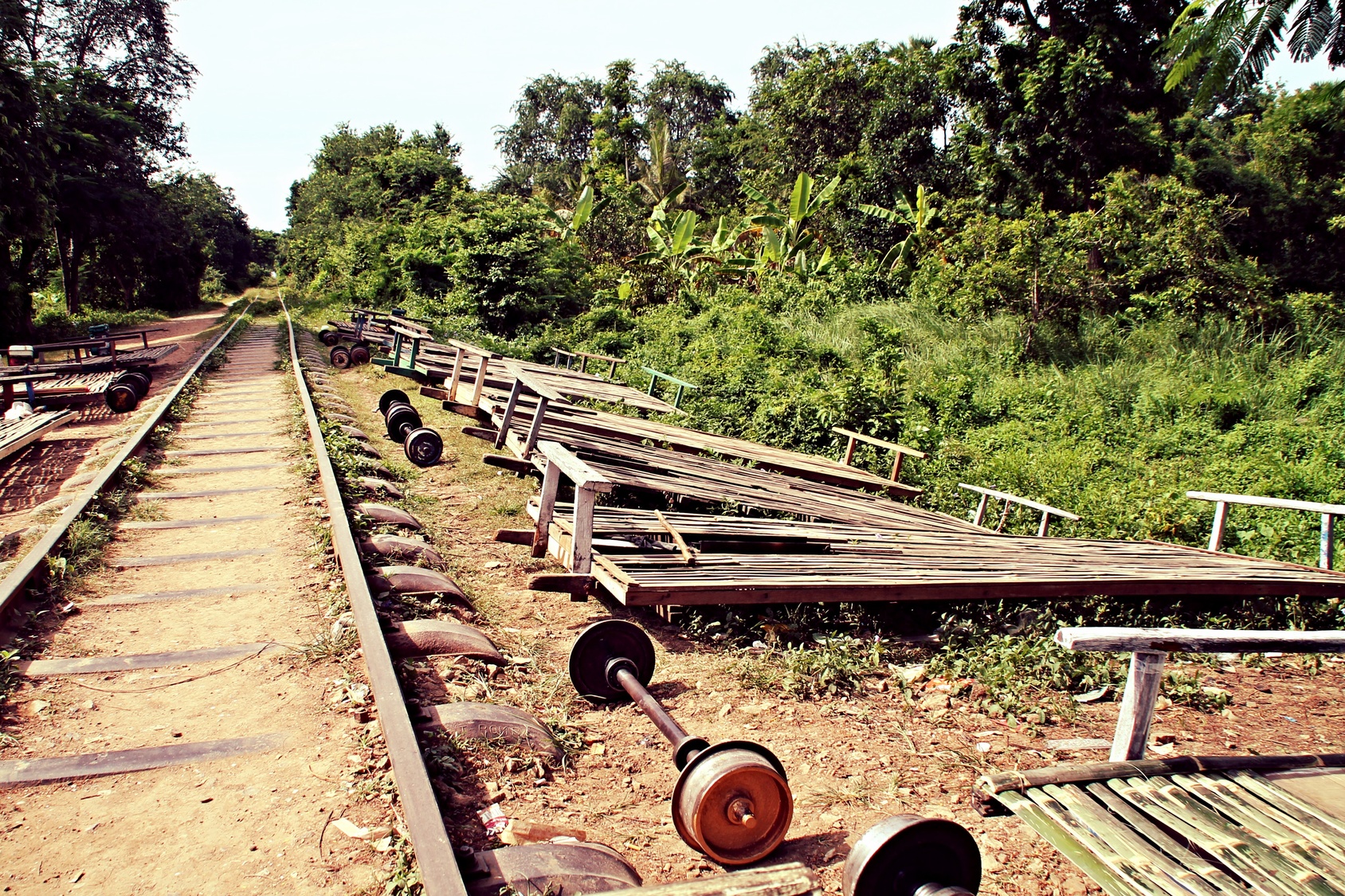
With a picturesque riverside setting, Battambang represents for many visitors the essential and authentic Cambodia and is a lovely example of a preserved French colonial destination. The countryside around this town is scattered with ancient temple sites which are often deserted and a ride on the bamboo train (think bamboo platform trolley with wheels) has become an almost essential must-do for tourists while in town.

